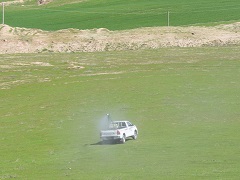1)Project Title:
Project for Improvement of Locust Management in Afghanistan, Kyrgyzstan and Tajikistan
2) Scheme
Grant Aid
3) Project Budget:
500 million Japanese Yen (effective amount received - 4.85 million USD as of December 2015).
4) Project Duration:
December 2015 - December 2018
5) Target Area:
The project will focus on the provinces that are the most affected by locusts: in Afghanistan, the five northern provinces sharing borders with Tajikistan, namely Baghlan, Balkh, Kunduz, Samangan and Takhar; in Kyrgyzstan, Batken, Jalal-Abad and Naryn; and in Tajikistan, Khatlon in the South and Sughd provinces in the North.
6) Counterpart Agencies:
- United Nations Food and Agriculture Organization (FAO)
7) Project Objective:
The overall objective of the project will be to contribute to food security and livelihood of the rural populations in Central Asia by preventing and limiting the threats posed by locusts and damage to crops and rangelands in the respect of human health and the environment.
8) Project Scope / Activities:
- Facilitation in regional exchanges to manage locust situations and organization of joint or cross-border surveys;
- Organization of trainings and expose visit, development of Practical Guidelines;
- Strengthening operational capacities for locust field survey and developing locust monitoring and analyzing systems;
- Strengthening operational capacities for locust control and ensuring management of pesticides delivered within the project;
- Monitoring and mitigating impact of locust control operations on human health and the environment.
9) Expected Results:
- Regional cooperation developed;
- National capacities strengthened;
- Locust monitoring improved;
- Locust control operations supported;
- Risk reduction on Human Health and the Environment ensured;
10) Beneficiaries:
Ultimate beneficiaries are rural populations living in the locust distribution areas, with estimation of beneficiaries reaching 11.2 million in all three countries.
11) Contributing to the NDS 2016-2030:
To ensure food security and providing better access for the population to quality nutrition (promotion of agriculture reform, specifically priority).
12) Contribution to SDGs:
End poverty in all its forms, achieve food security and promote sustainable agriculture (SDGs 1 and 2).

Locust spraying with vehicles





scroll